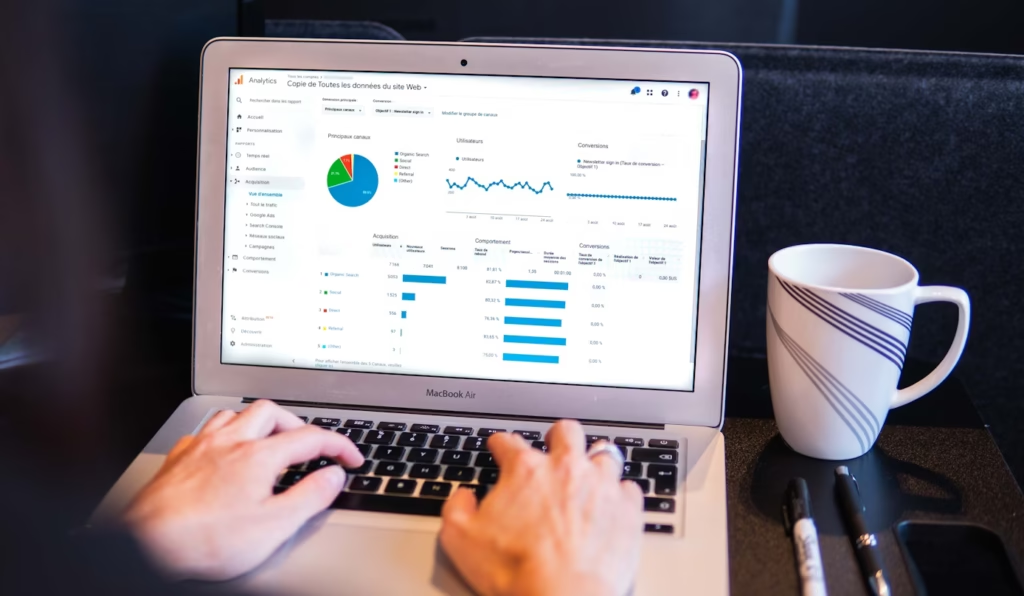Understanding key metrics in Google Ads Analytics can feel like deciphering a sophisticated puzzle. Yet, for small businesses in Toronto, it’s vital to grasp these metrics to boost ad performance. These insights work like a compass, guiding your advertising strategy in the right direction. By delving into the basics of these metrics, business owners can make smart, data-driven decisions that directly impact their marketing success.
Imagine running a coffee shop on a busy Toronto street. Your shop gets lots of pedestrians passing by, but how do you know if they’re interested in stepping inside for a cup of coffee? Metrics in Google Ads work similarly to track online traffic and engagement with your ads. They tell you who clicks, who checks out, and who sips that metaphorical coffee. Knowing these numbers is like having a chat with every customer who walks through your door, understanding their preferences and needs.
Key Metrics to Track in Google Ads Analytics
When managing Google Ads, there are a few important metrics that every business should focus on:
– Click-Through Rate (CTR): This metric shows how often people who see your ad actually click on it. A high CTR indicates that your ad is grabbing attention.
– Conversion Rate: After clicking your ad, this metric measures the percentage of people who complete a desired action, like making a purchase or signing up for a newsletter.
– Cost Per Conversion: This gives insight into the average cost of acquiring a customer through your ad, helping you evaluate the return on investment.
– Bounce Rate: It reflects the percentage of visitors who land on your site and leave without interacting further. A high bounce rate might suggest that the landing page isn’t engaging enough.
– Quality Score: A critical metric that depicts the relevance and quality of your ads. It can influence your ad’s position and cost.
Grasping these metrics provides a comprehensive view of your ad performance, enabling informed decisions on where to tweak and optimize. By keeping tabs on these indicators, you anticipate how effectively your ad spend translates into tangible results.
How to Use These Metrics to Improve Your Google Ads Campaign
Understanding what metrics mean is just the beginning. The real power lies in how you leverage them to refine your advertising efforts. By examining each metric closely, you learn what’s working and what’s not, helping you make better choices. Start by analyzing the data:
– Look closely at the conversion rate to see how well your ads are turning interest into actions. A low conversion might indicate the need to test different landing pages or ad copy.
– Assess your CTR to judge the effectiveness of your ad headlines and designs. High impressions but low clicks imply you might need a more enticing call to action.
– Evaluate the cost per conversion to ensure your advertising expenses align with your business goals. Higher costs might require a reassessment of your targeting approach or keyword strategy.
Once you’ve interpreted the data, the next step is making informed adjustments. Maybe it’s refining the keywords you’re bidding on or tweaking the ad copy to resonate better with your audience. This continuous cycle of review and adjustment helps set new goals, keeping your campaign dynamic and in line with market trends.
Making Data-Driven Decisions
Applying insights from your Google Ads metrics leads to smarter, more targeted decisions. With each bit of data, you’re better equipped to craft campaigns that speak directly to customers’ needs. This focus on what’s actually happening with your ads boosts your ability to drive success.
For instance, a Toronto bakery could use these metrics to spot that afternoon ads work best for promoting sweet treats. Watching these metrics means staying informed about your campaign performance. When you understand what the data is telling you, you can be swift in responding to changes, whether it’s testing a new ad format or exploring fresh keywords.
Regularly monitoring your campaigns ensures they’re aligned with your business objectives. The process isn’t just about numbers but making sure your ads are as effective as possible. By staying on top of these metrics, small businesses can confidently navigate the ever-changing advertising landscape, setting the stage for growth and success.
To make the most of your Google Ads, working with a Google Certified Digital Marketer in Toronto can help refine your approach and maximize your ad spend. GC Paid Media is here to help you fine-tune current campaigns or explore new strategies that lead to measurable success.





